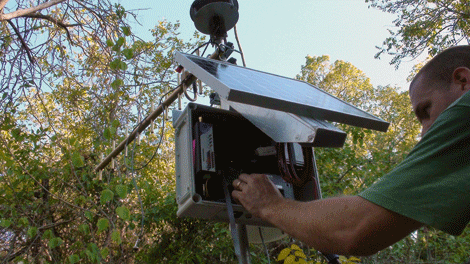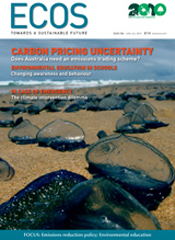
|
Published:
Bioacoustics: tuning in to nature
Monitoring biodiversity in remote Cape York Peninsula – with its annual Big Wet and vast distances – has always been a challenge for ecologists. CSIRO has been developing a bioacoustic network system that enables city-based researchers to monitor wildlife in remote areas from their desktop, with the help of local communities.

|
|
The solar-powered bioacoustic sensor unit can record animal sounds and read temperature and humidity. Credit: Eric Vanderduys
|
While Australia’s northern tropical savannas are considered among the best preserved in the world, their biodiversity is still under threat from burning, grazing and other land management activities.
But wildlife surveys – a traditional approach to measuring biodiversity – have their limitations, according to CSIRO’s Justin Perry.
‘We miss a lot in our surveys, such as seasonal visitors to the area, birds that only call occasionally and small mammals that avoid our traps,’ he says. ‘Weather and access are a big problem and there’s only a certain amount of time that we can spend in the field.’
With over 90 per cent of birds and frogs identified by call, a solution being trialled by Perry and his team is to build a wireless network of bioacoustic sensors that record acoustic and environmental data and send it back to their laboratory in Townsville via a mobile broadband connection.
The sensors can continuously gather data over a large area to provide detailed information about different species. This provides a snapshot of the ecological community at a particular time and place – an advantage over traditional field surveys.
Another advantage of the technology is that it may also allow those living in remote communities to help collect data without requiring high levels of training.
Working with local indigenous rangers, Perry’s team has deployed two bioacoustic devices in rainforest at Pormpuraaw, on the west coast of Cape York Peninsula.
The devices record bird sounds in the mornings and frog sounds in the evenings, and read temperature and humidity every five minutes. Data is sent twice daily to a computer server in Brisbane, where results are displayed in a spectrogram – a continuous graph of sound frequency over time. Researchers use the spectrograms to identify the unique sound signature of each bird or frog species.
So far the sensors have survived five months in the field, weathering 1.5 metres of rain, temperatures over 40 degrees and humidity of up to 98 per cent. The sensors are powered by two small, solar-charged, 12-volt batteries, similar to motorcycle batteries.
Perry says the quality of sound recorded during the Pormpuraaw trial has been excellent. However, the two sensors generate nearly two hours of data every day, representing calls of up to 40 different species of birds and eight different frog species – a lot to analyse. The researchers are now looking at automating the spectrographic analysis and species identification process.
Overall, the Pormpuraaw bioacoustics trial has been encouraging. The researchers have already noticed distinct patterns in frog vocalisations when compared with changes in temperature, rainfall and humidity. They believe the technique could be used more widely for faunal monitoring elsewhere in remote and regional Australia. For example, it could assist land managers and indigenous communities during controlled burning programs.
Bioacoustic monitoring could also act as an early warning system to alert managers to changes in species behaviour, such as breeding times or population distribution, in response to climate change.
In fact, the CSIRO team plans to deploy the sensors at Mount Bellenden Ker – one of Queensland’s tallest mountains – to measure the effect of subtle shifts in climate at different elevations on frogs. This will help to quantify the likely impacts of climate change.
Perry is particularly interested in the technology’s capability beyond single-location sound collection.
‘We want to use the technology to collect directional data. Using sound to pinpoint an animal’s position in the landscape may be the future of movement studies that currently use invasive radio-tracking techniques,’ he says.
‘For relatively little investment, we could potentially set up a network of bioacoustic devices across northern Australia that will work tirelessly to collect data – regardless of the weather.’




